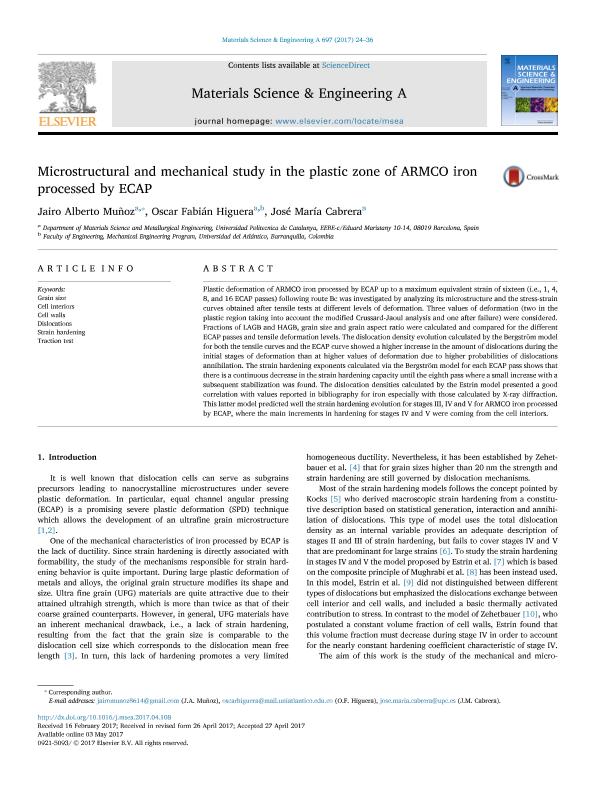Mostrar el registro sencillo del ítem
dc.contributor.author
Muñoz Bolaños, Jairo Alberto

dc.contributor.author
Higuera Cobos, Oscar Fabián

dc.contributor.author
Cabrera, José María
dc.date.available
2020-01-09T20:41:04Z
dc.date.issued
2017-06
dc.identifier.citation
Muñoz Bolaños, Jairo Alberto; Higuera Cobos, Oscar Fabián; Cabrera, José María; Microstructural and mechanical study in the plastic zone of ARMCO iron processed by ECAP; Elsevier Science Sa; Materials Science and Engineering A: Structural Materials: Properties, Microstructure and Processing; 697; 6-2017; 24-36
dc.identifier.issn
0921-5093
dc.identifier.uri
http://hdl.handle.net/11336/94227
dc.description.abstract
Plastic deformation of ARMCO iron processed by ECAP up to a maximum equivalent strain of sixteen (i.e., 1, 4, 8, and 16 ECAP passes) following route Bc was investigated by analyzing its microstructure and the stress-strain curves obtained after tensile tests at different levels of deformation. Three values of deformation (two in the plastic region taking into account the modified Crussard-Jaoul analysis and one after failure) were considered. Fractions of LAGB and HAGB, grain size and grain aspect ratio were calculated and compared for the different ECAP passes and tensile deformation levels. The dislocation density evolution calculated by the Bergström model for both the tensile curves and the ECAP curve showed a higher increase in the amount of dislocations during the initial stages of deformation than at higher values of deformation due to higher probabilities of dislocations annihilation. The strain hardening exponents calculated via the Bergström model for each ECAP pass shows that there is a continuous decrease in the strain hardening capacity until the eighth pass where a small increase with a subsequent stabilization was found. The dislocation densities calculated by the Estrin model presented a good correlation with values reported in bibliography for iron especially with those calculated by X-ray diffraction. This latter model predicted well the strain hardening evolution for stages III, IV and V for ARMCO iron processed by ECAP, where the main increments in hardening for stages IV and V were coming from the cell interiors.
dc.format
application/pdf
dc.language.iso
eng
dc.publisher
Elsevier Science Sa

dc.rights
info:eu-repo/semantics/openAccess
dc.rights.uri
https://creativecommons.org/licenses/by-nc-sa/2.5/ar/
dc.subject
CELL INTERIORS
dc.subject
CELL WALLS
dc.subject
DISLOCATIONS
dc.subject
GRAIN SIZE
dc.subject
STRAIN HARDENING
dc.subject
TRACTION TEST
dc.subject.classification
Ingeniería de los Materiales

dc.subject.classification
Ingeniería de los Materiales

dc.subject.classification
INGENIERÍAS Y TECNOLOGÍAS

dc.title
Microstructural and mechanical study in the plastic zone of ARMCO iron processed by ECAP
dc.type
info:eu-repo/semantics/article
dc.type
info:ar-repo/semantics/artículo
dc.type
info:eu-repo/semantics/publishedVersion
dc.date.updated
2020-01-09T17:33:41Z
dc.journal.volume
697
dc.journal.pagination
24-36
dc.journal.pais
Países Bajos

dc.journal.ciudad
Amsterdam
dc.description.fil
Fil: Muñoz Bolaños, Jairo Alberto. Universidad Politécnica de Catalunya; España. Consejo Nacional de Investigaciones Científicas y Técnicas. Centro Científico Tecnológico Conicet - Rosario. Instituto de Física de Rosario. Universidad Nacional de Rosario. Instituto de Física de Rosario; Argentina
dc.description.fil
Fil: Higuera Cobos, Oscar Fabián. Universidad Politécnica de Catalunya; España. Universidad del Atlántico; Colombia
dc.description.fil
Fil: Cabrera, José María. Universidad Politécnica de Catalunya; España
dc.journal.title
Materials Science and Engineering A: Structural Materials: Properties, Microstructure and Processing

dc.relation.alternativeid
info:eu-repo/semantics/altIdentifier/url/https://www.sciencedirect.com/science/article/abs/pii/S0921509317305907
dc.relation.alternativeid
info:eu-repo/semantics/altIdentifier/doi/http://dx.doi.org/10.1016/j.msea.2017.04.108
Archivos asociados
